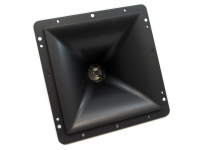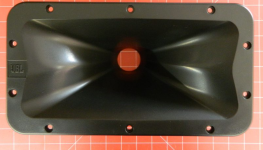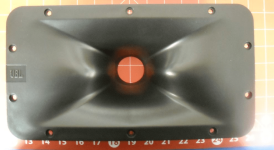I've come to the conclusion that it'll be much cheaper to use the speaker I got and trying to get it proper than to buy a whole new one...
I'm wondering if a technician could possibly realign the voice coil or if that's not real then I'll just buy the recon kit.
@weltersys What you suggest might work as well but I just don't know how to do it.
I'm wondering if a technician could possibly realign the voice coil or if that's not real then I'll just buy the recon kit.
@weltersys What you suggest might work as well but I just don't know how to do it.
I was really hoping that this was the issue but unfortunately voice rub seems to be the culprit.I once had similar issues and suspected voice coil rub - but in the end it was a noisy air leak. Could it be that?
The mumps not only reduce beaming and waistbanding, but also acoustically extend the horn's path length, thus lowering the cutoff frequency.
The small K510 loads the driver from about 500Hz, which is exceptionally low, considering its limited depth.
Is it possible to cover the whole spectrum, medium SPL, low distortion with a 2-way?
But how to add the mumps to this presumably perfect clone? https://www.ebay.com/itm/233808725468Surprised with a horn this popular https://community.klipsch.com/topic...river-recommendations/page/5/#comment-2887562
that I've yet to find a complete set of measurements; FR, spectral decay, distortion, polar charts, et al.
Otherwise, the K510 seems like a great solution for my midwoofers. https://josephcrowe.com/blogs/news/altec-416-8b-in-100l-sealed
But how so compared to the JBL 2384
or which other JBL horns?
Non-TAD Beryllium suggested driver models?
The JBL should be better overall, if only for its size.
Of all the Klipsch horns, I like this one the best, but it's too small and equipped with the 'wrong' driver

Of the waveguide-like horns with mumps, cheeks etc., this is one of the better options (JBL #5006815):

This 70° × 70° variant (JBL #5006219) is also highly regarded:

Of all the Klipsch horns, I like this one the best, but it's too small and equipped with the 'wrong' driver

Of the waveguide-like horns with mumps, cheeks etc., this is one of the better options (JBL #5006815):

This 70° × 70° variant (JBL #5006219) is also highly regarded:

Last edited:
Just go Purify. 8" with their new tweeter. For lower SPL you could even build it closed volume and put as much low end in as you like and what your room fits, in ported volume it should go pretty deep. When you accept 2.5 ways it should be good for bigger rooms and HiFi SPL levels.Is it possible to cover the whole spectrum, medium SPL, low distortion with a 2-way?
Certainly is possible, depending on how you define "medium SPL" and "low distortion".Is it possible to cover the whole spectrum, medium SPL, low distortion with a 2-way?
Carefully, lest you catch the disease 😱But how to add the mumps to this presumably perfect clone?
Throat "mumps" should be designed into the horn, not pasted on to a conical/tractrix knockoff.
- Home
- Loudspeakers
- Multi-Way
- Is it possible to cover the whole spectrum, high SPL, low distortion with a 2-way?